 Sous l’égide du Ministère de la Culture en partenariat avec l’UNESCO, cet événement commémore la date anniversaire de l’adoption par l’Assemblée Générale des Nations Unies, de la Convention pour la répression et l’abolition de la traite des êtres humains et de l’exploitation de la prostitution d’autrui, le 02 décembre 1949.
Sous l’égide du Ministère de la Culture en partenariat avec l’UNESCO, cet événement commémore la date anniversaire de l’adoption par l’Assemblée Générale des Nations Unies, de la Convention pour la répression et l’abolition de la traite des êtres humains et de l’exploitation de la prostitution d’autrui, le 02 décembre 1949.
Un combat de tous les jours
La célébration de cette journée, tout en s’inspirant de l’esprit de l’abolition de la traite des noirs, actualise le combat permanent contre toutes les autres formes d’esclavage moderne qui privent à de très nombreux êtres humains, leurs libertés et leurs droits les plus élémentaires à la dignité, au travail libre, à la vie tout simplement.
Kofi Annam, le Secrétaire Général des Nations Unies, dans son message du 02 décembre 2001, en rappelant l’abolition de l’esclavage, ajoutait ceci: » Bien des gens pensent sans doute que ce traité n’a plus lieu d’être au XXIe siècle. Or il nous faut bien admettre que l’esclavage et la servitude restent encore trop fréquents, cachés sous les noms de travail obligatoire, travail forcé, exploitation de la main d’œuvre enfantine et traite des êtres humains « , marginalisation, exclusion des groupes sociaux.
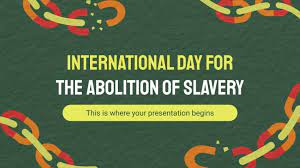 L’esclavage actuel
L’esclavage actuel
Aujourd’hui, le travail forcé et l’exploitation sexuelle dont sont victimes les enfants, la prostitution des femmes. Le traitement discriminatoire des travailleurs migrants, les agressions quotidiennes contre les droits de l’homme la détérioration des termes de l’échange, le poids de la dette inique et injuste ont autant de formes de privation de libertés synonymes d’un esclavage de type moderne.
L’ONU et ses organismes affiliés en collaboration avec la communauté internationale ( ONU, syndicats, société civile…), renforcent leurs instruments internationaux pour l’éradication de toutes ces t’ormes modernes d’esclavage. Il s’agit notamment de l’adoption de nouvelles conventions:
La Convention internationale sur la protection des droits de tous les travailleurs migrants et des membres de leur famille; 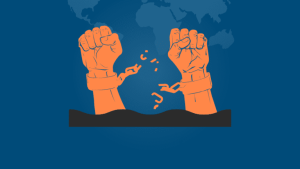
La Convention des Nations Unies contre la criminalité transnationale organisée;
La Déclaration de la Conférence mondiale contre le racisme etc…
Approfondir la réflexion sur l’ensemble de ces questions, sensibiliser l’opinion sur cette lutte actuelle contre l’esclavage de type moderne, tels sont les enjeux de la célébration de cette Journée Internationale pour l’abolition de l’esclavage du 02 décembre.
Objectifs
Vulgariser et sensibiliser l’opinion sur les graves violations des libertés individuelles en particulier le trafic des enfants et des femmes;
Développer et partager la réflexion sur la nécessaire mobilisation de tous les secteurs de la société pour combattre ce fléau;
Amener les Etats et les Institutions internationales à faire à appliquer les traités internationaux et les lois nationales.
Un site à visiter : www.un.org Source: Texte & Images: Journée Mondiale 2è image: National Day Calendar
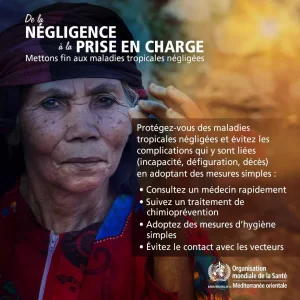 Le 31 mai 2021, l’Assemblée mondiale de la santé (AMS) a reconnu le 30 janvier Journée mondiale des maladies tropicales négligées (MTN) par la décision WHA74(18).
Le 31 mai 2021, l’Assemblée mondiale de la santé (AMS) a reconnu le 30 janvier Journée mondiale des maladies tropicales négligées (MTN) par la décision WHA74(18).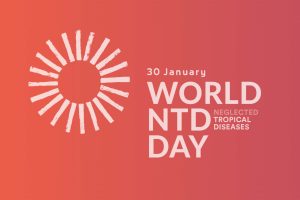 On 31 May 2021, the World Health Assembly (WHA) recognized 30 January as
On 31 May 2021, the World Health Assembly (WHA) recognized 30 January as 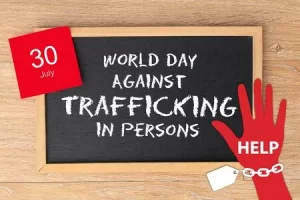 THEME 2022: “Use and abuse of technology”
THEME 2022: “Use and abuse of technology”  Sous l’égide du Ministère de la Culture en partenariat avec l’UNESCO, cet événement commémore la date anniversaire de l’adoption par l’Assemblée Générale des Nations Unies, de la Convention pour la répression et l’abolition de la traite des êtres humains et de l’exploitation de la prostitution d’autrui, le 02 décembre 1949.
Sous l’égide du Ministère de la Culture en partenariat avec l’UNESCO, cet événement commémore la date anniversaire de l’adoption par l’Assemblée Générale des Nations Unies, de la Convention pour la répression et l’abolition de la traite des êtres humains et de l’exploitation de la prostitution d’autrui, le 02 décembre 1949. L’esclavage actuel
L’esclavage actuel
 In honor of World Polio Day, CDC will celebrate and highlight polio eradication work around the globe using Twitter and Facebook. Tweets will feature the efforts and photos of CDC staff deployed in the field who are working to end polio. CDC will also create a photo gallery on the Center for Global Health Facebook page to feature images of polio eradication work done by CDC and partners worldwide.
In honor of World Polio Day, CDC will celebrate and highlight polio eradication work around the globe using Twitter and Facebook. Tweets will feature the efforts and photos of CDC staff deployed in the field who are working to end polio. CDC will also create a photo gallery on the Center for Global Health Facebook page to feature images of polio eradication work done by CDC and partners worldwide. « Endemic sexual violence including rape, abduction, human trafficking, sexual slavery and forced marriage contributes to the disproportionate suffering of women and girls in conflict. » — UN Secretary-General, António Guterres
« Endemic sexual violence including rape, abduction, human trafficking, sexual slavery and forced marriage contributes to the disproportionate suffering of women and girls in conflict. » — UN Secretary-General, António Guterres
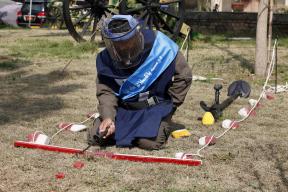 The United Nations’ International Day for Mine Awareness and Assistance in Mine Action is observed on April 4 each year. This day aims to raise awareness about landmines and progress toward their eradication.
The United Nations’ International Day for Mine Awareness and Assistance in Mine Action is observed on April 4 each year. This day aims to raise awareness about landmines and progress toward their eradication.